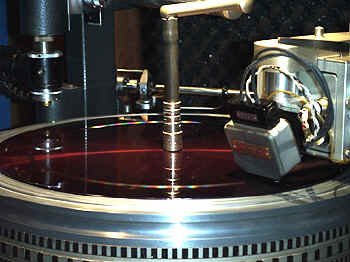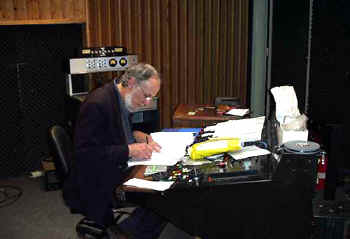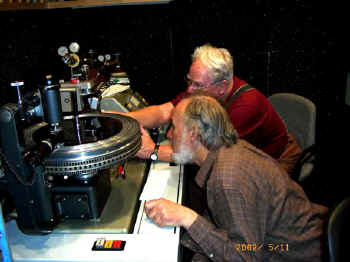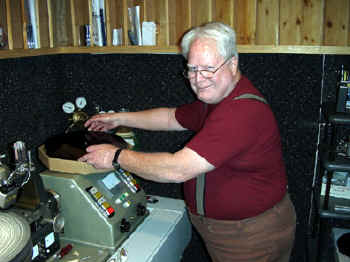You are reading the older HTML site
Positive Feedback ISSUE 2
august/september 2002
Mastering Maven Mills Microscopically Minute Miracle
by Dave Glackin and Stan Ricker
Photographs courtesy of John Wood/Mobile Fidelity; digital processing by David W. Robinson

Mobile Fidelity Sound Lab has been resurrected from the ashes of the old company, as described in my report on the 2002 CES (Positive Feedback Online Issue 1). The head of the new MoFi is Jim Davis of Music Direct. John Wood is the director of New Technology. The company has been set up back in the original studio in Sebastopol, California. Right out of the box, they’re bringing out the big guns. MoFi’s audio dream team is a stellar line-up: Stan Ricker and Paul Stubblebine are doing the mastering, Tim de Paravicini has built the cutting amps and tape-repro electronics, and Ed Meitner is responsible for the digital electronics. As most of you reading this should be aware, Stan mastered most of the original big MoFi titles that were issued on half-speed-mastered vinyl. (When you have a few hours to kill, please see my interview with Stan, reprinted in Positive Feedback Online Issue 1, 2, coming soon 3.)
Tim de Paravicini has built cutting amps electronics for many companies over the years, and his reputation as a genius in this area precedes him. His overriding goal is that his electronics be able to pass a 100Hz square wave intact. For MoFi, Tim built a system using tube amps to drive the Ortofon cutterhead. (The mastering chain originally used a JVC console from Paul Stubblebine... the same console Stan used at the JVC Cutting Center.) During the time that this system was in its genesis, Stan described to me the "team struggle" that it took to get everything right. It paid off.

Tim de Paravicini hard at work
Just after the system was first tested in May, 2002, Stan fired off an e-mail in which he expressed the most excitement that I have ever seen from him in print. And that’s really saying something. The reborn MoFi has developed a world-class mastering system.
In July, this system was found to have recorded a signal of astoundingly high frequency onto a lacquer. Stan sent me the relevant details, and I did an independent calculation of the frequency that agreed with his own: 122kHz when played at 33 1/3 rpm. Yowza! I’ll yield the floor to Stan, and let him tell the story in his own unique way. As you’ll see, Stan has a little problem with being too quiet in print.. Dave Glackin
For the first time, we may not have to cut at half-speed to achieve our quality goals.
It’s really great working with Paul Stubblebine on this, as I appreciate an extra pair of really great ears. He was blown away by the first cut we did, as were all of us in the room... Tim, Paul, John Wood, myself. We just set the tape machine alignment tones at -4 and connected it directly to the lathe (cutting) amps and let it roll, and voila ... gorgeous music! This system is unf!@#$%^ing believable!
As you know, at MoFi, there has always been the push to extend the bandwidth; to push and expand the envelope, so to speak... well, here's almost too much bandwidth...
We picked up, off the tape, at half-speed, the record-bias on the master tape (30 ips, half-inch tape). We first discovered it by blowing a fuse in the cutterhead protection circuit while doing some trial-cutting on our very first attempt at half-speed through Tim de Paravicini’s tape repro and cutter-drive amps. I thought this was pretty darn unusual, as cutter-current is supposed to be between one-half to one-fourth of the real-time needs, but the clipping indicators on Tim’s amps were activating.

Tim and Stan at the lathe
When I looked at the lacquer, then I realized what was happening at the cutterhead-end of things. There were light-diffraction rainbows all over the lacquer, like what you see off the data-side of a CD. At first, I thought that there was some kind of oscillation in the cutter-amps in the half-speed mode, but when I cut silent grooves with the tape machine stopped, no such condition was seen. But when we turned the tape machine on, the signal immediately showed up, and could be seen on the X-Y oscilloscope connected to the monitor at the console. Purposely misaligning the tape-repro azimuth -just a little bit-made the problem totally go away. So there was the living proof that the culprit was actually a healthy record-bias signal imprinted on the tape.
In order to try to calculate the frequency, I cut a few grooves' worth of this signal at a 10-inch diameter. I turned the eye-piece of the microscope sideways, and counted 7 complete cycles per 0.001-inch division. I did the basic math and figured it was right at 61 kHz, more than 2 octaves higher than the FM carrier (15 kHz) we used in cutting the JVC CD-4 Quadraphonic records! (That’s 122kHz when played back at 33 1/3 rpm!)

Stan with a laquer
We were scratching our heads trying to find out what tape machine had such a bias frequency. John Wood did some really great detective work as to where the tape (of Dave Alvin) was recorded, and on what machine. John found the studio, found the engineer, found the machine; found that the machine was an older MCI JHD 110D, a 4-track that had been converted to a half-inch 2-track. A bit more sleuthing turned up the fact of the MCI bias-freq being 120KHz... BINGO! We had our proof!
We made test pressings cut at real-time and at half-speed. The half-speed stuff was the clear winner... HALF-SPEED LIVES!!!
P.S. I just sent this on to MoFi so that they can build a tunable bias trap, as this HF takes all the energy from the cutter-amps, and really heats up the head... almost too hot to touch. Running the cooling helium wide open was the only way we could do it. Stan Ricker
Wrap-up by Dave Glackin
There you have it. 122 kHz, folks. The highest frequency ever committed to a vinyl LP designed for playback at 33 1/3 rpm, to our knowledge. You heard it here first. So when you slap one of MoFi’s new slabs-o’-vinyl on your turntable and turn up the volume, be sure and send your dog to another room. Along with your pet bat. They’ll be glad you did. Wait a minute... whazzat, Stan? You say that this incredibly high frequency won’t actually be on the MoFi LPs that the public can buy. What is this... you’re keeping all the good stuff for yourself? Oh. You say the cutter head will fry, so you’re filtering out the HF. And unsuspecting audiophiles’ cartridges may not like it either? Well, save those lacquers. They’ll be valuable collector’s items someday. I can see the e-bay auctions now...
